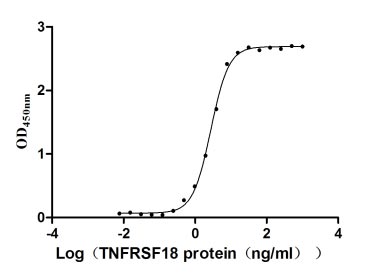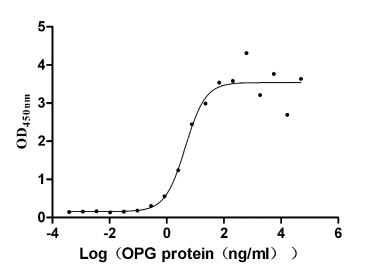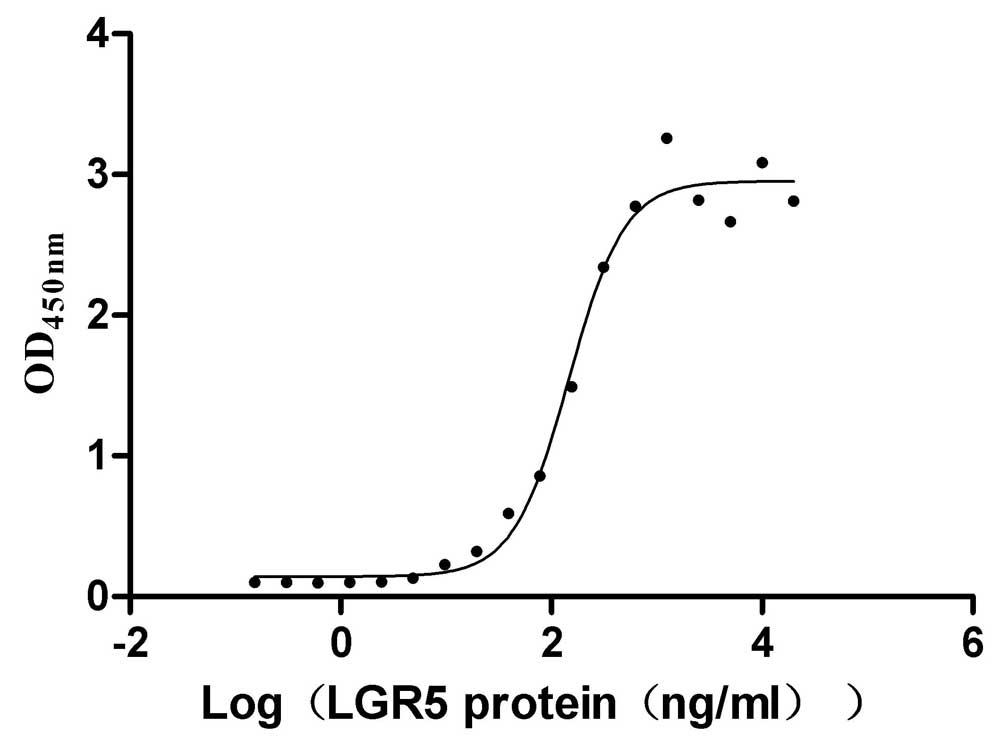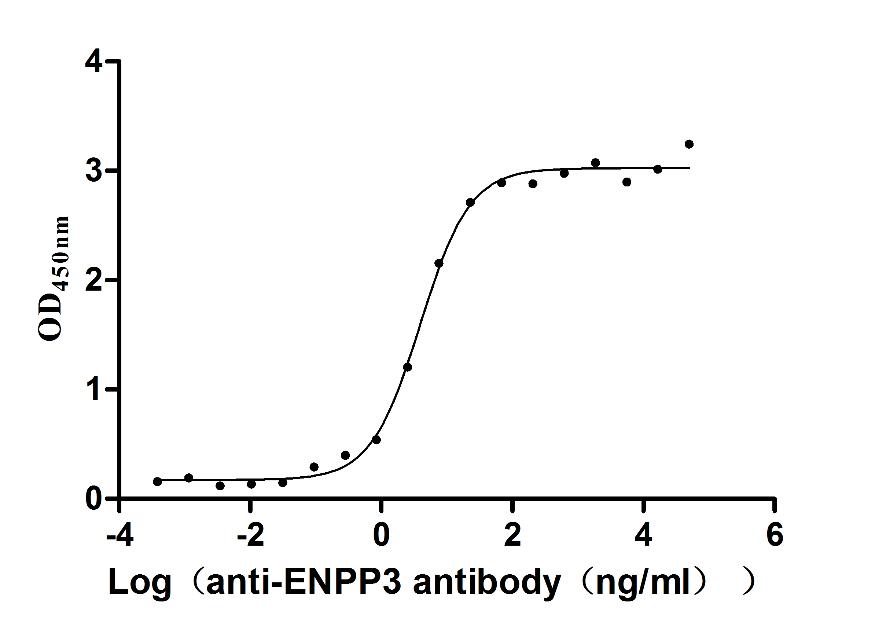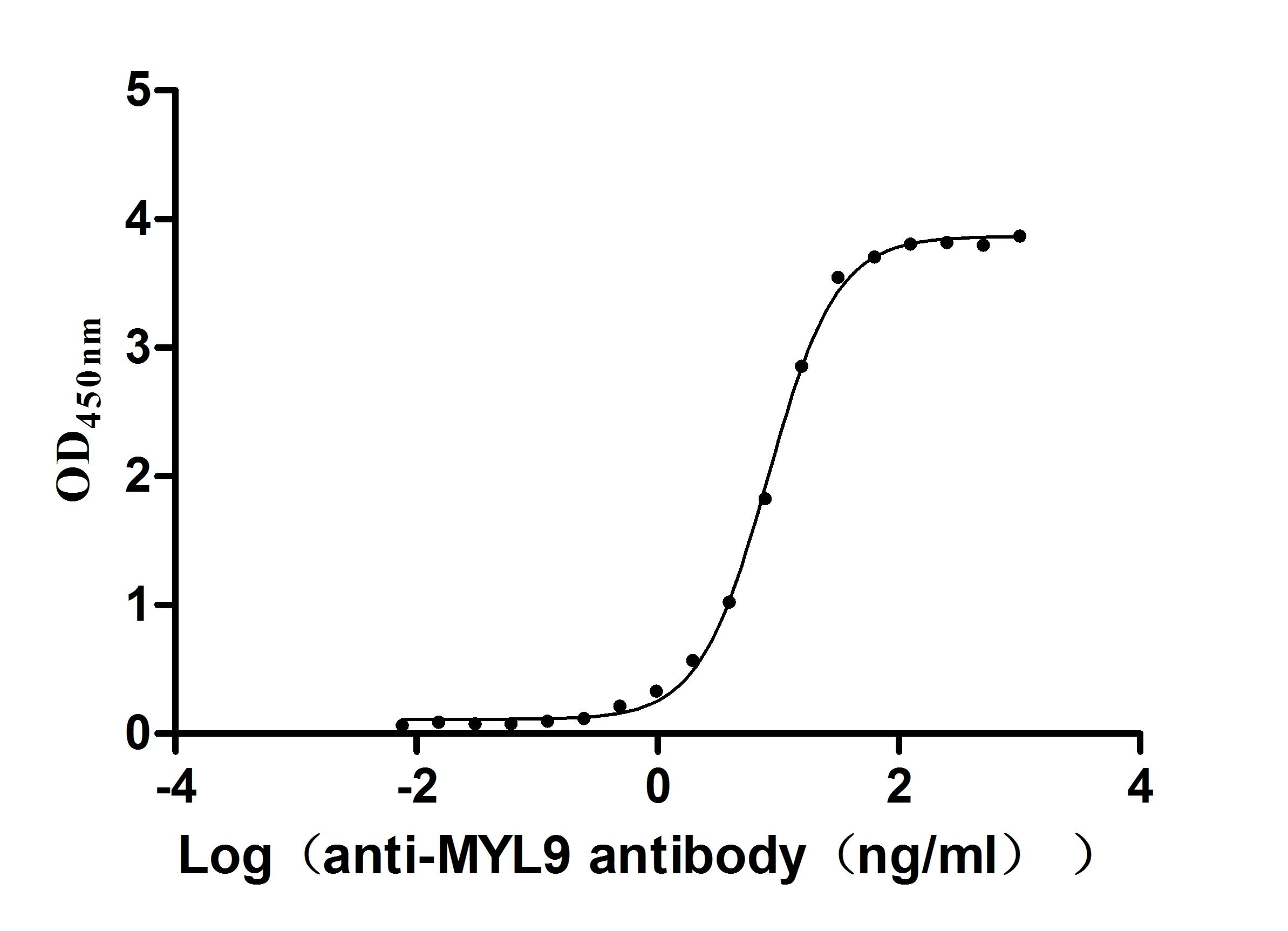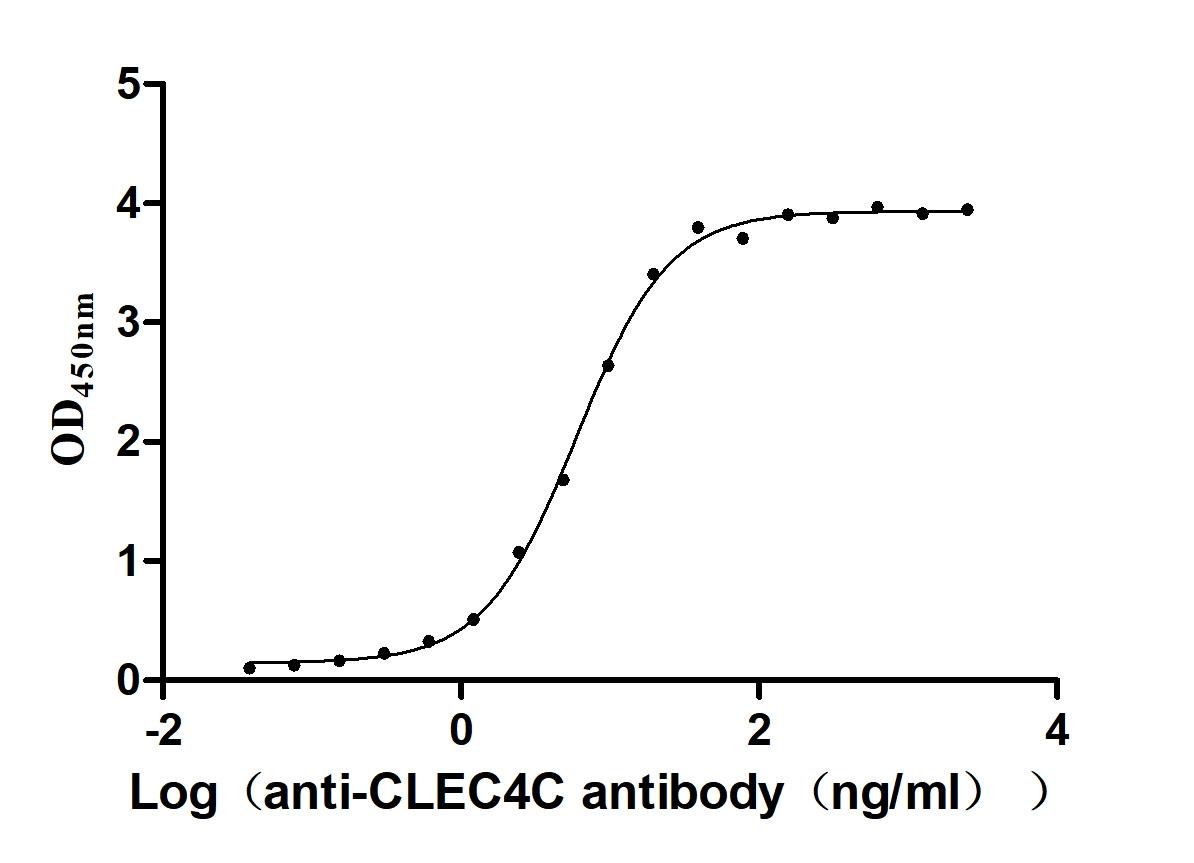Recombinant Human CST complex subunit STN1 (OBFC1)
-
中文名称:人STN1重组蛋白
-
货号:CSB-YP880983HU
-
规格:
-
来源:Yeast
-
其他:
-
中文名称:人STN1重组蛋白
-
货号:CSB-EP880983HU
-
规格:
-
来源:E.coli
-
其他:
-
中文名称:人STN1重组蛋白
-
货号:CSB-EP880983HU-B
-
规格:
-
来源:E.coli
-
共轭:Avi-tag Biotinylated
E. coli biotin ligase (BirA) is highly specific in covalently attaching biotin to the 15 amino acid AviTag peptide. This recombinant protein was biotinylated in vivo by AviTag-BirA technology, which method is BriA catalyzes amide linkage between the biotin and the specific lysine of the AviTag.
-
其他:
-
中文名称:人STN1重组蛋白
-
货号:CSB-BP880983HU
-
规格:
-
来源:Baculovirus
-
其他:
-
中文名称:人STN1重组蛋白
-
货号:CSB-MP880983HU
-
规格:
-
来源:Mammalian cell
-
其他:
产品详情
-
纯度:>85% (SDS-PAGE)
-
基因名:STN1
-
Uniprot No.:
-
别名:AAF 44; AAF44; Alpha accessory factor 44; bA541N10.2; CST complex subunit STN1; FLJ22559; Obfc1; Oligonucleotide/oligosaccharide binding fold containing 1; Oligonucleotide/oligosaccharide-binding fold-containing protein 1; OTTHUMP00000020417; OTTHUMP00000020418; Replication protein A 32 kDa subunit; RP11-541N10.2; RPA 32; STN1; STN1_HUMAN; Suppressor of cdc thirteen; Suppressor of cdc thirteen homolog
-
种属:Homo sapiens (Human)
-
蛋白长度:full length protein
-
表达区域:1-368
-
氨基酸序列MQPGSSRCEE ETPSLLWGLD PVFLAFAKLY IRDILDMKES RQVPGVFLYN GHPIKQVDVL GTVIGVRERD AFYSYGVDDS TGVINCICWK KLNTESVSAA PSAARELSLT SQLKKLQETI EQKTKIEIGD TIRVRGSIRT YREEREIHAT TYYKVDDPVW NIQIARMLEL PTIYRKVYDQ PFHSSALEKE EALSNPGALD LPSLTSLLSE KAKEFLMENR VQSFYQQELE MVESLLSLAN QPVIHSASSD QVNFKKDTTS KAIHSIFKNA IQLLQEKGLV FQKDDGFDNL YYVTREDKDL HRKIHRIIQQ DCQKPNHMEK GCHFLHILAC ARLSIRPGLS EAVLQQVLEL LEDQSDIVST MEHYYTAF
-
蛋白标签:Tag type will be determined during the manufacturing process.
The tag type will be determined during production process. If you have specified tag type, please tell us and we will develop the specified tag preferentially. -
产品提供形式:Lyophilized powder
Note: We will preferentially ship the format that we have in stock, however, if you have any special requirement for the format, please remark your requirement when placing the order, we will prepare according to your demand. -
复溶:We recommend that this vial be briefly centrifuged prior to opening to bring the contents to the bottom. Please reconstitute protein in deionized sterile water to a concentration of 0.1-1.0 mg/mL.We recommend to add 5-50% of glycerol (final concentration) and aliquot for long-term storage at -20℃/-80℃. Our default final concentration of glycerol is 50%. Customers could use it as reference.
-
储存条件:Store at -20°C/-80°C upon receipt, aliquoting is necessary for mutiple use. Avoid repeated freeze-thaw cycles.
-
保质期:The shelf life is related to many factors, storage state, buffer ingredients, storage temperature and the stability of the protein itself.
Generally, the shelf life of liquid form is 6 months at -20°C/-80°C. The shelf life of lyophilized form is 12 months at -20°C/-80°C. -
货期:Delivery time may differ from different purchasing way or location, please kindly consult your local distributors for specific delivery time.Note: All of our proteins are default shipped with normal blue ice packs, if you request to ship with dry ice, please communicate with us in advance and extra fees will be charged.
-
注意事项:Repeated freezing and thawing is not recommended. Store working aliquots at 4°C for up to one week.
-
Datasheet :Please contact us to get it.
靶点详情
-
功能:Component of the CST complex proposed to act as a specialized replication factor promoting DNA replication under conditions of replication stress or natural replication barriers such as the telomere duplex. The CST complex binds single-stranded DNA with high affinity in a sequence-independent manner, while isolated subunits bind DNA with low affinity by themselves. Initially the CST complex has been proposed to protect telomeres from DNA degradation. However, the CST complex has been shown to be involved in several aspects of telomere replication. The CST complex inhibits telomerase and is involved in telomere length homeostasis; it is proposed to bind to newly telomerase-synthesized 3' overhangs and to terminate telomerase action implicating the association with the ACD:POT1 complex thus interfering with its telomerase stimulation activity. The CST complex is also proposed to be involved in fill-in synthesis of the telomeric C-strand probably implicating recruitment and activation of DNA polymerase alpha. The CST complex facilitates recovery from many forms of exogenous DNA damage; seems to be involved in the re-initiation of DNA replication at repaired forks and/or dormant origins. Required for efficicient replication of the duplex region of the telomere. Promotes efficient replication of lagging-strand telomeres. Promotes general replication start following replication-fork stalling implicating new origin firing. May be in involved in C-strand fill-in during late S/G2 phase independent of its role in telomere duplex replication.; Component of the CST complex, a complex that binds to single-stranded DNA and is required to protect telomeres from DNA degradation. The CST complex binds single-stranded DNA with high affinity in a sequence-independent manner, while isolated subunits bind DNA with low affinity by themselves. In addition to telomere protection, the CST complex has probably a more general role in DNA metabolism at non-telomeric sites.
-
基因功能参考文献:
- CTC1-STN1 terminates TERT while STN1-TEN1 enables C-strand synthesis during telomere replication in colon cancer cells. PMID: 30026550
- CTC1/STN1/TEN1 (CST) deficiency diminishes HU-induced RAD51 foci formation. PMID: 27487043
- STN1-POLA2 interaction provides a basis for primase-polymerase alpha stimulation by human STN1. A disease-causing mutation in human STN1 engenders a selective defect in POLA2-binding. PMID: 28934486
- The findings imply that theCTC1/STN1/TEN1 complex(CST )complex plays an important role in regulating telomere maintenance in alternative-lengthening of telomeres(ALT) cells. PMID: 28366536
- TERT-mediated G-strand extension and Ctc1-Stn1-Ten1-mediated C-strand fill-in are equally important for telomere length maintenance. PMID: 28334750
- Mutations in STN1 cause Coats plus syndrome and are associated with genomic and telomere defects. PMID: 27432940
- The mammalian CST (CTC1-STN1-TEN1) complex is directly involved at several stages of telomere end formation and CST seems to play critical roles in coordinating telomerase elongation and fill-in synthesis to telomere replication. PMID: 23851344
- we explored two SNPs in genes associated either with telomere biology (OBFC1) or with LTL (OBCF1 and CTC1). Interestingly, we observed that genetic variation does not account for LTL at birth PMID: 25598199
- A 2-SNP OBFC1 haplotype was associated with higher risk of CHD, and a 3-SNP TERC haplotype was associated with both higher risk of CHD and T2D. PMID: 24349443
- The Stn1 deficiency leads to persistent and elevated association of DNA polymerase alpha to telomeres, suggesting that Stn1 may modulate the DNA synthesis activity of polalpha rather than controlling the loading of polalpha to telomeres. PMID: 22964711
- the requirement for STN1/CST in telomere duplex replication correlates with increasing telomere length and replication stress. PMID: 23142664
- CTC1-STN1-TEN1 complex rescues stalled replication forks during conditions of replication stress, such as those found at natural replication barriers, likely by facilitating dormant origin firing PMID: 22863775
- the human CST (CTC1, STN1 and TEN1) complex, previously implicated in telomere protection and DNA metabolism, inhibits telomerase activity through primer sequestration and physical interaction with the protection of telomeres 1 (POT1)-TPP1 telomerase processivity factor PMID: 22763445
- Ctc1-Stn1-Ten1 is a replication protein A (RPA)-like complex that is not directly involved in conventional DNA replication at forks but plays a role in DNA metabolism frequently required by telomeres. PMID: 19854130
- Genome-wide association identifies OBFC1 as a locus involved in human leukocyte telomere biology. PMID: 20421499
- OBFC1 is identical to the previously described 44 kDa subunit of DNA-pol-alpha/primase associated factor (AAF) which increases polymerase-alpha/primase template affinity and stimulate both DNA primase and polymerase-alpha activities in vitro. PMID: 19119139
显示更多
收起更多
-
相关疾病:Cerebroretinal microangiopathy with calcifications and cysts 2 (CRMCC2)
-
亚细胞定位:Nucleus. Chromosome, telomere.
-
蛋白家族:STN1 family
-
数据库链接:
HGNC: 26200
OMIM: 613128
KEGG: hsa:79991
STRING: 9606.ENSP00000224950
UniGene: Hs.62314
Most popular with customers
-
Recombinant Human Tumor necrosis factor receptor superfamily member 18 (TNFRSF18), partial (Active)
Express system: Mammalian cell
Species: Homo sapiens (Human)
-
Recombinant Human Tumor necrosis factor receptor superfamily member 11B (TNFRSF11B) (Active)
Express system: Mammalian cell
Species: Homo sapiens (Human)
-
Recombinant Human R-spondin-1 (RSPO1), partial (Active)
Express system: Mammalian cell
Species: Homo sapiens (Human)
-
Express system: Mammalian cell
Species: Macaca fascicularis (Crab-eating macaque) (Cynomolgus monkey)
-
Recombinant Human Zymogen granule protein 16 homolog B (ZG16B) (Active)
Express system: Mammalian cell
Species: Homo sapiens (Human)
-
Recombinant Human Myosin regulatory light chain 12B(MYL12B) (Active)
Express system: E.coli
Species: Homo sapiens (Human)
-
Recombinant Macaca fascicularis C-type lectin domain family 4 member C(CLEC4C), partial (Active)
Express system: Mammalian cell
Species: Macaca fascicularis (Crab-eating macaque) (Cynomolgus monkey)


